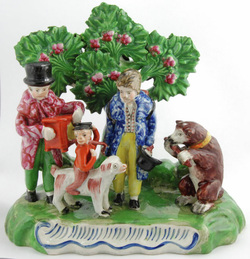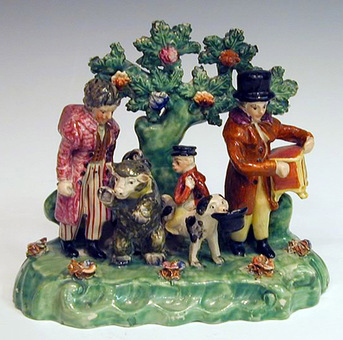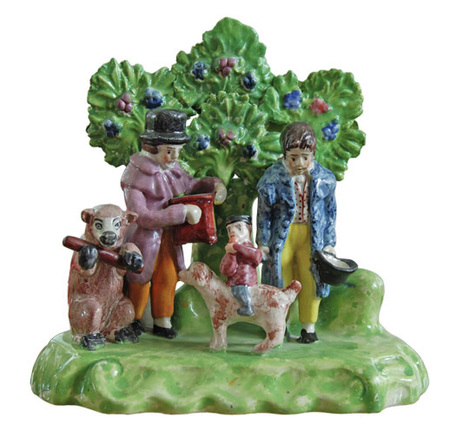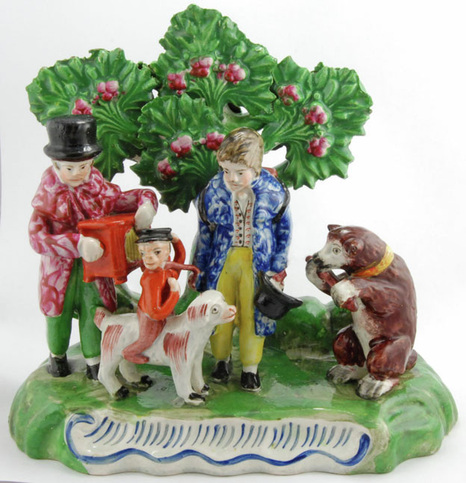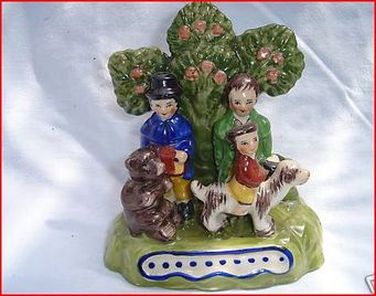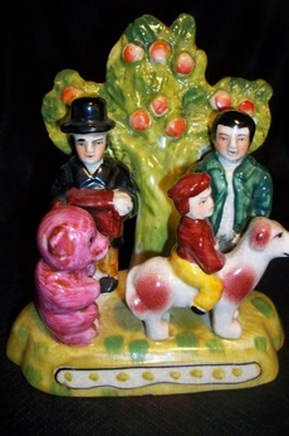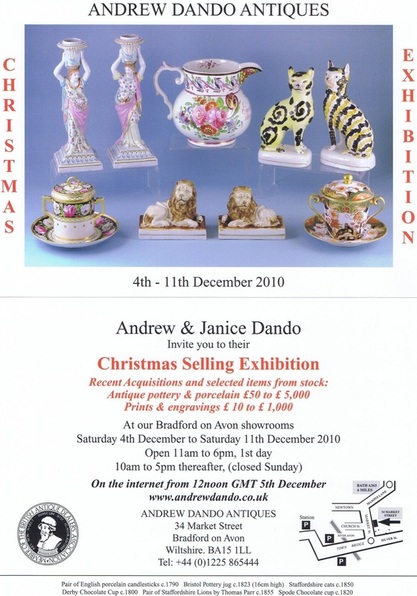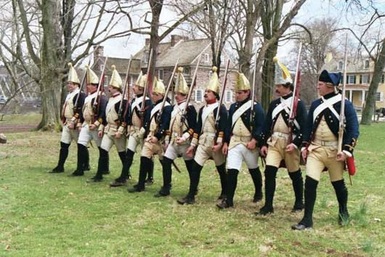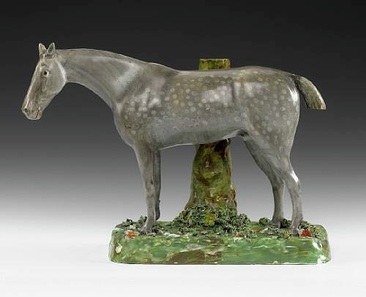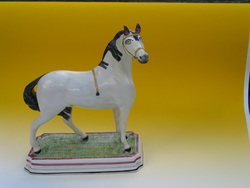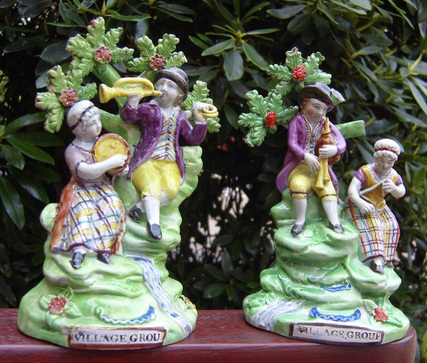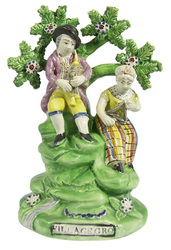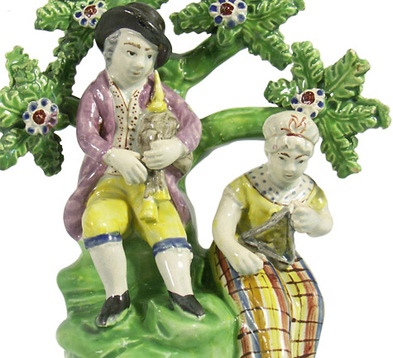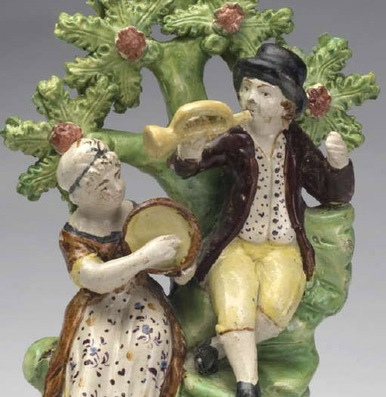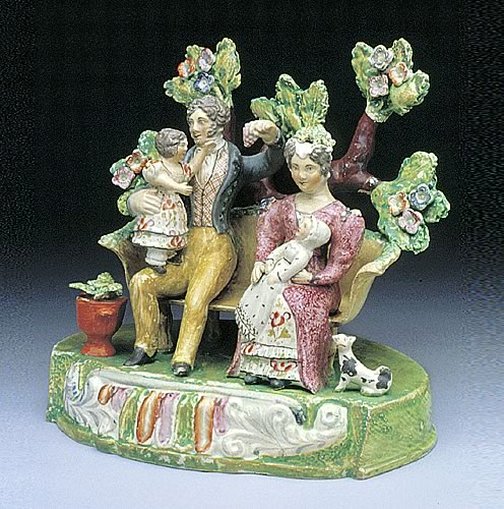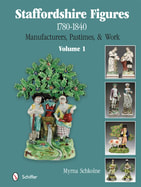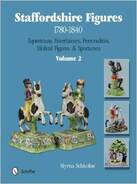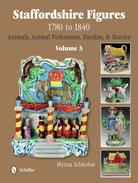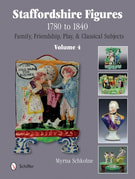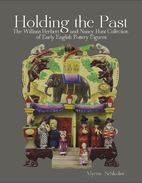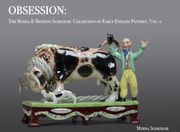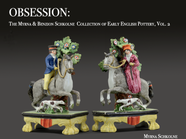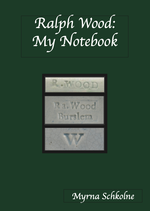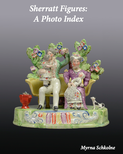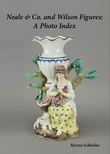|
Last posting, I noted how very rare performing animal troupes are. I thought you might like to see this pair. They comprise the usual cast of characters from the troupe that occurs on a single base. Instead, the figures are arranged on two bases here. These figure pairs are unique. Yes, the enamels are brilliant--yet not as garish as the photo makes them appear. Best of all, the only restoration is to the the very tips of the bocage. You may note that in the group on a single base the man with the blue coat holds a hat, but the man doesn't hold a hat in the paired grouping. The hat has not been lost. The figure was made that way.
0 Comments
I have wanted a performing animal troupe for a long time--and to me The Real Thing requires no food. It's pearlware of course. Why haven't I bought one sooner? Well, firstly, they are very thin on the ground. And secondly, I am too picky. To me it is essential that ALL the figures on the group be original. I can tolerate repair and restoration to the group, but not a whole made up figure. The first group that made the cut came up about a decade ago. Lovely, but it didn't quite pass muster. There were restorations to the figures, minor as best I recall. That was not the problem. I just didn't like the bocage. It was sparse, more trunk than leaves. And the leaf tips looked nibbled and restored, which they were. If I had known then what I know now about the rarity of these groups, I might have succumbed. But I didn't. So the long wait began. I will admit, as best I recall, nothing more came to market in the next ten years. And the groups I saw in collections were either missing figures or had nasty restoration. Here the dog and monkey and bear have been significantly/totally restored and I suspect there is restoration to the other figures and bocage. Just kills the group for me. The best things are worth waiting for, and at last this group came my way. To see it is enough. I don't need to own it. Just great to know of a good example out there. Now isn't that much nicer? Can you seen the vitality in the original modeling? Love the monkey. The only restoration here is to the tip of the stick the bear holds and to enamel flaking. Of course, at the other end of the 'collecting' extreme is this abomination, available most any day on eBay. Touted as "Staffordshire", these groups are not English. They are Asian. Repro is too kind a description. These figures are modern junk. A picture is worth a thousand words, so look at the pictures and note the features that pinpoint their status: the crudest of modeling, minimal detailing, and ghastly color palettes.
Andrew and Janice Dando December Exhibition is around the corner. Details below and on the Dando site. I suspect that the Dandos, like all dealers, have less pottery in stock than they would like. So little has come to market in the past year or two. People are holding on. I admit to being guilty of that too. I really should thin my shelves---but economic pundits tell us we are about to hit a period of rapid inflation and when that happens I expect pottery prices to soar. Maybe that will finally bring a flood of new wares onto the market.
I am always on the lookout for figures I haven't seen before. Whether for sale or in a collection, I don't care. I don't have to own them, I just want to know about them. So I was ecstatic when I was able to get a photograph of these three gentlemen recently. The figures are a nice size, about 8" tall. They represent Hessian soldiers. So what is a Hessian soldier? King George III was also Elector of Hanover, a German principality. When in the 1770s he needed soldiers to fight those American revolutionaries, King George looked across the Channel to his ancestral home and conscripted about 30,000 soldiers to fight for Britain. Some were subjects of Hanover, but the conscripted fighters were all called Hessians because the largest group came from the German principality of Hesse-Kassel. The men were not mercenaries as we know them today. Some were impressed into service, others were forced to serve because they were conscripts, petty thieves, or debtors. Pay was poor and often consisted of daily food, with wages being sent back to the soldiers' German rulers! Despite this, the Hessians were highly respected fighters, and their discipline earned them the admiration of friend and foe alike. After the Revolutionary War, some Hessians settled in America and Canada of choice. Others had to stay because their rulers did not want them back! You can read tons on the web about Hessians. The soldiers wore blue coats, buff breeches, and distinctively pointed headgear of the form worn by our three figures. Here you can see want-to-be Hessians in a modern day Revolutionary War reenactment. Seems Hessians were particulary fond of music and, of course, they had regimental bands. In the Revolutionary War, a Hessian officer named Colonel Rall conducted a regimental band that was much admired. And after the war, a Hessian band played at George Washington's inauguration.
The Hessian soldier continued to be useful after Britain's American issue was resolved. Britain contracted to bring 12,000 Hessians into the British army for four years from around 1793. And in 1798, Hessians put down a rebellion in Ireland. Thereafter, I don't believe Hessians fought for Britain again. They did fight across Europe for other forces, but as warfare in the early 1800s changed the structure of Europe, Hessian soldiers passed into the mists of time. So back to our Staffordshire figures. They are driving me nuts. Because of the nature of the subject, surely they date from the 1790s? Did more than three figure forms comprise a full band? How many of each form was made? These figure required complex molds. Hundreds, if not thousands, must have been made to justify the creation of the molds. Why do only three survive? PS.I asked collector Mary Berk if the Hessian on the right was playing a transverse flute. Her answer is fascinating. Thanks, Mary! I am 99% sure that the instrument is a fife as in fife and drum corps. My flute history books suggest that the Swiss first used the fife and drum in their militia. The famous Revolutionary War painting is of a fife, drum and flag carrier. In the state of NY there was a school in the 1800's dedicated to teaching all the calls and commands that the fife and drum gave to the troops for daily routines as well as the war maneuver calls. The fife was later usurped by the trumpet and the trumpet made obsolete by radio signals in the world wars. Coming up at Bonhams London next month is this large pearlware horse, around 9" tall. The catalog listing notes that an identical horse, again standing in front of a spill vase, can be found on page 291 of People, Passions, Pastimes, and Pleasures: Staffordshire Figures 1810-1835. I had forgotten that!! The horse in my book is paired with a cow and both are actually marked Wood and Caldwell. The bases on both horses are strewn with the same flowers we find on other Wood and Caldwell figures. Pearlware enamel-painted horses are really quite rare. Most commonly they occur with riders, but unmounted horses are few and far between. The largest unmounted horses were made by Leeds. At about 18 inches, they are magnificently impressive. 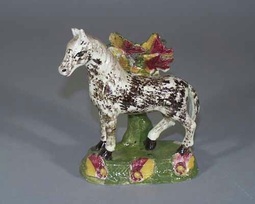 At the other end of the size spectrum this 5" pottery horse, formerly in Vandkar's stock, is particularly engaging. The color palette suggests it is Scottish. The bocage is very unusual in both form and color. How often do you see pink and yellow bocage leaves? 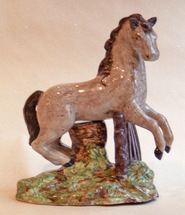 This rearing horse was formerly in the stock of the late Jonathan Horne. I have seen this horse on a plinth base, in the stock of the late Allistair Sampson. 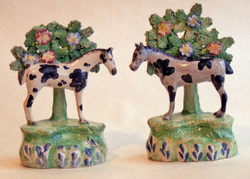 These horses were also formerly in the late Jonathan Horne's stock. They are made by the manufactory that Malcolm Hodkinson has dubbed 'Big Flower" because it favored large bocage flowers, just like those you see here. I have seen these horses painted in different colors but I know of no other pair. A horse, of course? Don't take it for granted. An enamel-painted horse is far from common. If you know of any other examples, please share.
Reference Works, the global source for reference books on ceramics, has a new online shop where you can browse the books. Click here to see it and build your library. I have yet to regret a single reference book I have purchased. Each one has a use at some point in time.
I admit I am enjoying my Facebook activity and in particular the pottery posts of fellow enthusiasts. Facebook provides a quick and easy mechanism for alerting people to a great find on the web--or an iffy eBay listing. Even the Queen is now on Facebook, but you cannot 'friend' her. Find me as mystaffordshirefigures.com. All friends welcome!
I found this short Youtube clip fascinating. As you may know, Staffordshire did not become a pottery making hub because of its clay. Yes, the area had clay, but not the fine clay needed for earthenware manufacture. Staffordshire actually imported its clay. Watch what it took to get it. The secret to Staffordshire's dominance of the earthenware industry was its coal. It required as many as 12 tons of coal to fire one ton of clay--so clearly being near coal was more important than being near clay.
In my last posting, I show two different figure groups titled VILLAGE GROUP, noting that they could theoretically be paired. A collector has kindly shared his pair. I think this pair may have lived together always. Beautiful, bright enamels and the missing bocage branch doesn't bother me at all. Aren't they a lovely sight? Enjoy!
The quality of the enamels on a figure is very important to me. If a figure is very rare and structurally perfect but the enamels are awful, I don't want it. To put it in sexist terms, how many girls with gorgeous bodies and acne-pocked skin end up as cover girls? Enamel quality makes all the difference to the impact a figure has on the eye. These figures help me make my point. Click on each figure to enlarge it. These two groups are varying versions of the VILLAGE GROUP. Although they appear to pair, I have never seen a pair from this manufactory. Probably, they were sold as singles...and if you wished, you could buy two and make your own pair. The figure on the left has bright glossy enamels and it glows! The figure on the right, on the other hand, is ho-hum. Certainly not the worst enamels I have ever seen, but they appear yukky, dull, and worn. See what I mean? And how about this very rare group? Here the enamels are really nasty: discolored, mat, bubbly and just not pretty.
All this can be fixed with overpainting. The restorer simply puts a fresh coat of glossy stuff on top. The result is that you are looking at modern material, brand new paint. At times, it is needed and justified. Some flaking is almost commonplace and sympathetic retouching of the bare area is, to my mind, fine. The bad spot vanishes and no longer draws the eye. But when the majority of a figure is bad.....I go and shop for something else. Enameling was in its day a skilled process and required multiple firings. Some colors needed higher firing temperatures than others, so these colors were painted on first and the piece would go into the kiln. Next the process would be repeated with colors requiring a little less heat. I am not sure how many firings each figure needed, but I wouldn't be surprised to learn that it was usually at least three. Extraordinary skill was required because there was no way to measure kiln temperature. There were assorted ways of assessing the temperature--at best educated guesses--but there was no thermometer to measure that extreme heat. Very easy for things to go wrong, and they did. Enamels might be overfired or underfired, resulting in discoloration. Or the very mix of the enamel could result in poor adherence. The bottom line is that perfect, glowing enamels are a minor miracle, and that's why I admire them so much. |
Archives
February 2024
All material on this website is protected by copyright law. You may link to this site from your site, but please contact Myrna if you wish to reproduce any of this material elsewhere. |

